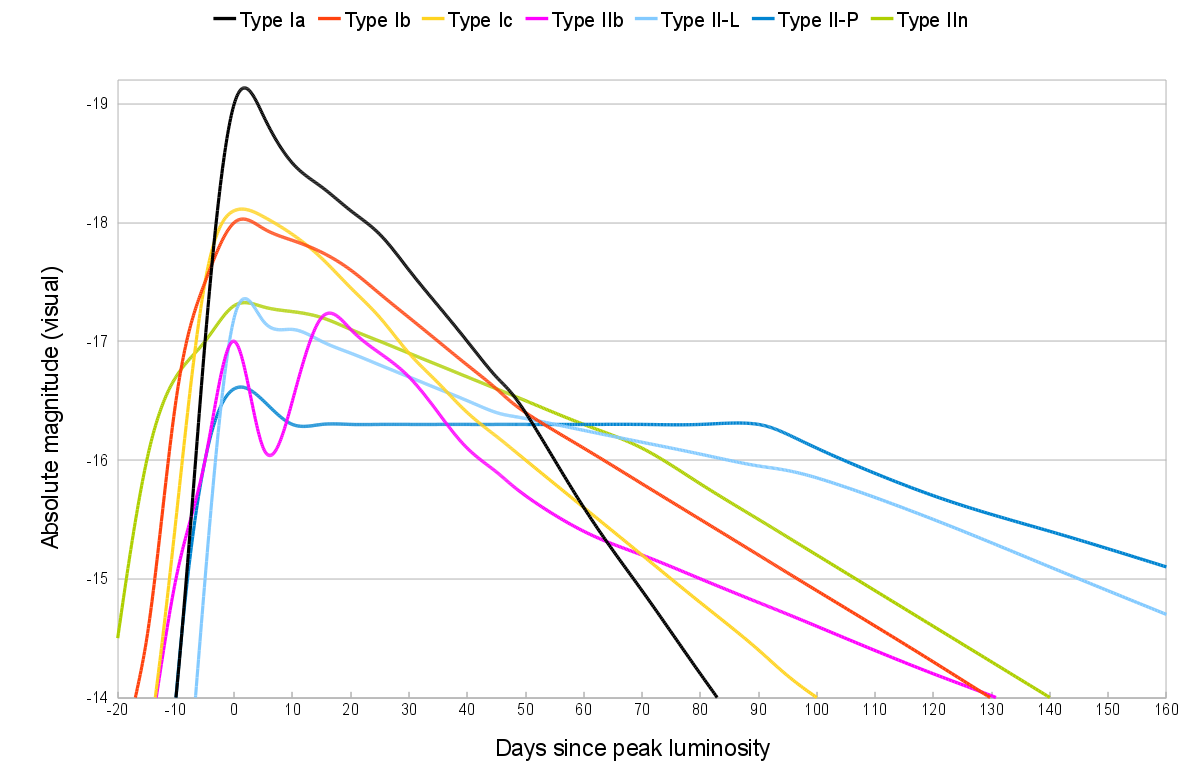|
Size: 1563
Comment:
|
Size: 2312
Comment:
|
| Deletions are marked like this. | Additions are marked like this. |
| Line 4: | Line 4: |
| The Sun's absolute bolometric (all band) magnitude is +4.74, 3.828 e26 W, so an absolute magnitude of zero is 3.013e28 W. | The Sun's absolute bolometric (all band) magnitude is +4.74, 3.828e26 W, so an absolute magnitude of zero is 3.013e28 W. |
| Line 28: | Line 28: |
| Supernovae Light Curves: | === Supernovae Light Curves: === |
| Line 31: | Line 31: |
(by litopsian on Wikipedia) |
|
| Line 43: | Line 45: |
------- === AL26 === The 1.8 MeV gamma emission of ^26^Al decay to ^26^Mn tells us about galactic frequency of Type II supernovae, about 2 per century , estimated from the gamma emissions from the ^26^Al around us, about 2.8 solar masses in the galaxy (5.6e30 kg). One supernova produces 2.5e26 kg of ^26^Al. The half life of ^26^Al is 717 ky, so the decay rate is 3e-14 per second, or 7e11 decays/kg-s, or 0.2 W/kg. Assuming 0.04 c radial velocity, and isotropic deposition at a distance of 100 light years (9.4605e17m) 2500 years later (0.25% has decayed), the deposited material density is 2.2e-11 kg/m^2^, the radioactivity is 4e-12 W/m^2^ or 7.4 MeV/m^2^-s or about 4 decays per second. Not much. |
Supernova effects on Server Sky and Stady Shell
The Sun's absolute bolometric (all band) magnitude is +4.74, 3.828e26 W, so an absolute magnitude of zero is 3.013e28 W.
Abs |
Watts |
10 pc |
100 pc |
Mag |
|
W/m² |
W/m² |
-19 |
1.2e36 |
100 |
1.00 |
-18 |
4.8e35 |
40 |
0.40 |
-17 |
1.9e35 |
16 |
0.16 |
-16 |
7.6e34 |
6.3 |
63m |
-15 |
3.0e34 |
2.5 |
25m |
-14 |
1.2e34 |
1.0 |
10m |
-13 |
4.8e33 |
0.4 |
4m |
gamma and X rays |
||
distance |
sn1a |
snII |
|
2e34W |
1e32W |
pc |
W/m² |
W/m² |
10 |
16.7m |
84μ |
30 |
1.86m |
9.3μ |
100 |
167μ |
840n |
300 |
18.6μ |
93n |
1000 |
1.67μ |
8.4n |
Type Ia |
2e44 J |
Supernovae Light Curves:
(by litopsian on Wikipedia)
- Stellar Interiors by Hansen+ QB808 H36 1994
- Table 6.3 p 247
- C + C → Ne + α 44% . . . C + C → Na + p 56%
- O + O → Si + α 21% . . . O + O → P + p 61% . . . O + O → Si + n 18%
- Thielemann and Arnett 1985 2x downloaded
- Truran 1966 (paywall)
- Bodansky Clayton Fowler 1968 2x downloaded
- Section 6.8 p251 Neutrino emission mechanisms
When temperatures are high enough - kT ~ 2 mec² photons creates electron positron pairs
- Ordered this book!
AL26
The 1.8 MeV gamma emission of 26Al decay to 26Mn tells us about galactic frequency of Type II supernovae, about 2 per century , estimated from the gamma emissions from the 26Al around us, about 2.8 solar masses in the galaxy (5.6e30 kg). One supernova produces 2.5e26 kg of 26Al. The half life of 26Al is 717 ky, so the decay rate is 3e-14 per second, or 7e11 decays/kg-s, or 0.2 W/kg. Assuming 0.04 c radial velocity, and isotropic deposition at a distance of 100 light years (9.4605e17m) 2500 years later (0.25% has decayed), the deposited material density is 2.2e-11 kg/m2, the radioactivity is 4e-12 W/m2 or 7.4 MeV/m2-s or about 4 decays per second. Not much.

